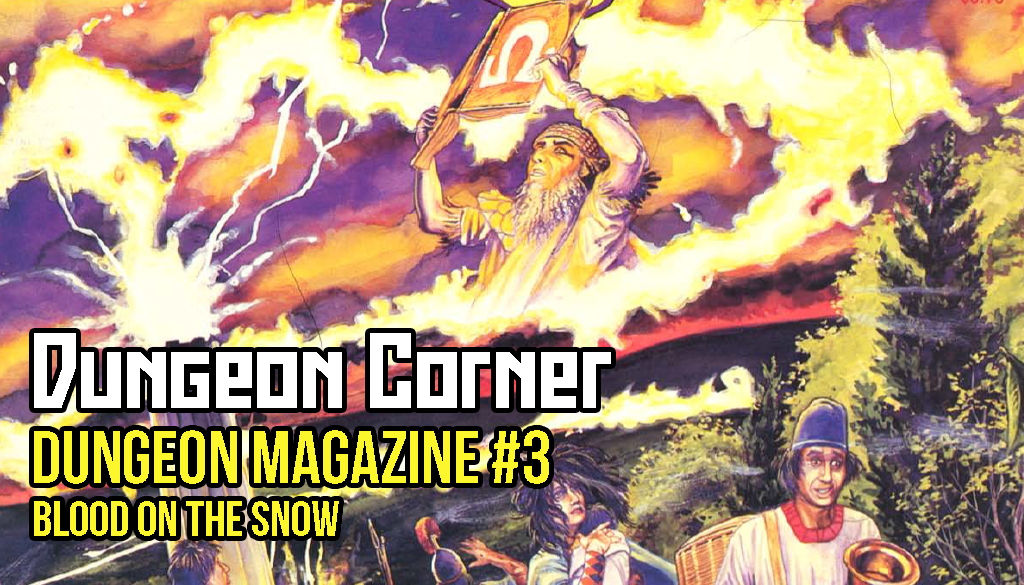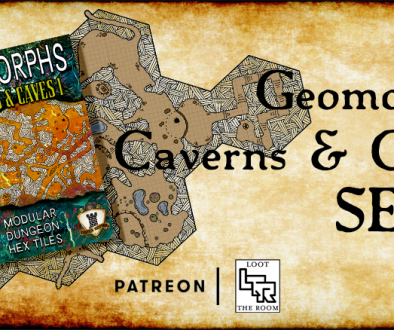Blood On The Snow
This post originally appeared on Patreon. Patrons get access to posts at least a week before they go live on Loot The Room, as well as to exclusive Patreon-only content. Tiers start at just £2 per month and your support helps to keep this site running. Sign up here.
You can find the other posts in this series here.
The author of “Blood On The Snow”, Thomas M Kane, is one of the most prolific writers we’ve encountered so far in our journey through Dungeon Magazine. I’m unable to find a complete bibliography for him, but as well as being published extensively in Dungeon and Dragon magazines he was also a regular contributor to White Wolf Magazine and has credits in books for Cyberpunk, GURPS, and Ars Magica, and appears to have a fairly successful career as a novelist. So fingers crossed this adventure is a good one. (I should also point out that this adventure features a couple of really lovely pen and ink illustrations by the late Jennell Jaquays).
“Blood On The Snow” is designed for 3-7 characters of 3rd-7th level, and we’re told that fighters, barbarians, and rangers would be “extremely helpful”. The characters are going to take on the roles of undercover agents, “observers who allow events to unfold around them in order to solve a mystery”. We’ve had a couple of decent mysteries in the pages of Dungeon already, and I’m interested to see how this one does things. We’re told up front that the DM is provided with a timeline of events, which is a good start, but also that they’ll need to be prepared to improvise “if the actions of the characters change the situation or the sequence of events”.
So what’s going on here? Seal hunters working on a peninsular glacier that they stole from “a warlike tribe” – read: its indigenous people, who they now pay as guides as the intruders hunt the ancient tribal territories – have come under threat from a gang of marauders who threaten their operation and make it nearly impossible to bring fur in from the ice. The marauders, we’re told, “seem to understand all the plans of the hunters”, and the local town’s merchant guildmaster believes that this is because one of the local hunters has betrayed them to the marauders. He fears that the traitor is the local guard captain, Kanadius, and he has called in the PCs to help. They’ve ostensibly been hired as hunters to replace those killed by the marauders, but they’re actually here to go undercover and discover the identity of the spy, should one actually exist.
Due to the nature of the adventure – the PCs going along with a hunting party – it’s almost necessarily on rails, and the module does acknowledge this. The PCs are encouraged to follow the lead of the NPCs and we’re given a timetable of the major events of each day. GMs are advised, though, that just because something happens every day doesn’t mean that the PCs are there to witness it, and that they should be actively spying, asking questions, and sneaking off to do their espionage. The GM is encouraged to “give them every opportunity to do this, using the schedule as a guide only”.
This module really emphasises how cold it is out on the glacier, giving us a fairly straightforward weather system to calculate the temperature and weather each day. Although the temperatures are given in Fahrenheit, which is entirely meaningless to me, I do like how simple this is to use. Each day you roll 2d20-28 to calculate a temperature between -30 to +12, and then you roll 2d20 to determine wind speed and alter the temperature accordingly:
| Wind Speed | Degrees to Subtract |
|---|---|
| 2-5 | 5 |
| 6-10 | 14 |
| 11-15 | 19 |
| 16-20 | 23 |
| 21-25 | 28 |
| 26-30 | 30 |
| 31-35 | 32 |
| 36-40 | 34 |
We’re also given rules for determining cloud cover (1-2 on 1d6) and snow (1-in-6), and told how being unprotected hinders characters: 1hp damage per hour for every 10 degrees below 40F, and 1hp per turn for every degree below -30F. There are also rules for potions, liquids, and limbs freezing, as well as snow blindness. It’s pretty brutal, and I like it a lot. That said, I don’t actually know how much a GM would end up using the weather tables – the timeline of events gives temperatures and wind strengths, plus details of snow, for many of the days that the journey takes place. It’s annoyingly inconsistent, and I almost wish that the timeline ignored weather entirely and just left it to the GM to adjudicate.
One missed trick here is that there’s no encounter table unique to this module. Instead we’re told that when PCs explore the ice by themselves we should use the “arctic, rough” table in the Fiend Folio or DMG, and then a number of exceptions and changes are given. Personally I think there should just be an encounter table here so that everything you need to run the adventure is in one place.
As with a lot of the wilderness and mystery adventures we’ve seen in Dungeon so far, a big chunk of this text is given over to detailing the local town of Winterwolf. Here at least the town is a little different to the others we’ve seen in the magazine, given that it’s based on Finnish history/folklore and is in an arctic setting as opposed to the standard medieval fantasy fare we’ve seen before, but I do wonder exactly how many small settlements that are only used for a single adventure have been detailed in the history of D&D. I’m not without sin, of course – Bodies In Flight and Beyond The Drowned Spire both have small villages next to the adventure in them – and I’m suddenly curious where this urge to write the world around the site of the adventure comes from. That’s food for thought for the future. Here we’re given a map of the settlement and details of the NPCs, but given that the bulk of the adventure is meant to take place out of the ice I’m not sure how useful all of this is really. I suppose it’s handy if you take the advice that the PCs should spend a month preparing for the expedition first, which allows you to use this settlement in your ongoing game and spend some time there before heading out onto the ice, but if you were running this as a one-shot you could dispense with the village almost entirely. That said, this thing is long and I think that trying to run it as a one-shot would be a fool’s errand, so in this case the town becomes much more useful.
The best part of this adventure is the combination of the timeline of the hunt – which includes notable events as well as the day’s seal take – and a map that shows the route of the hunting party around the glacier, with days and times given at specific locations. This means that the PCs can wander off and get lost on the ice and the GM will always know exactly where the hunting party is, which is a touch I really like. It also focuses on details that give us some sense of the tensions within the hunting party, like this from the first day:
The trail Ali has chosen leads through marshes which have only partially frozen. Much complaining about Ali is made by the hunters. Were it not for his choice of direction, the ice could be entered almost immediately, and the fens avoided. Ali remains passive, but when the complaints become loud, he warns that the bandits are believed to watch the quicker path to the ice.
Day 8 is also a particularly fun one, and a moment where the adventure could go wildly off the rails. If Ali is suspicious of the PCs or otherwise displeased with them he claims that some nearby hills are likely the be the bandit hideout and sends the PCs to investigate. Rather than bandits, though, the hills are home to a dragon, and his plan is for the PCs to simply never return. This is a moment where we’re told to “use random encounters and weather for moderating this task” once the PCs are on their own, and I desperately wish that this adventure had an encounter table – particularly as this would be a good opportunity to put the dragon on it. For each turn that characters spend within four hexes of the dragon’s lair there is a 10% cumulative chance that the dragon notices them, and I think the text here assumes that the dragon noticing the PCs must then lead to an encounter; the actual text, after giving this chance of being noticed, simply reads, “[the dragon] can speak and tries to gain from the encounter without fighting, threatening the party with death unless all valuables are brought forward. It then flaps its wings and charges to frighten the group away with its fear aura: if this doesn’t work, it uses its breath weapon and flies out of combat range to its cave”. This indicates to me that the dragon is active and roaming the territory around its lair, and I wish there was an opportunity here for the PCs to notice the dragon without it spotting them. I also wish it had a name.
After the timeline the adventure ends very abruptly. Either the PCs figure out who the traitor is, or they don’t, and it’s all over. In the event that they haven’t figured out who is to blame we’re told that the GM can either end the adventure here or else send the PCs out with the hunters again, hoping for more information to be uncovered. This time, though, the GM will have to come up with a new timeline of events for a second hunting expedition, presumably adding new clues as the identity of the traitor. I’m not sure whether any GMs would feel like doing that, especially as you’d essentially be running the same adventure again. Will players be up for a second trek across the ice with a group of hunters who are largely hostile to them? I’m not sure.
I’m undecided about this adventure. There are some cool things in it – I particularly like the rules for being out in the cold – but it feels very much like the author trying to make a specific story happen at the table, and that’s not the kind of game I like to run. With that said, though, this isn’t particularly far removed from the way lots of modern D&D players run the game, so if you’re into that sort of play style this might be worth bringing to your table. It definitely lends itself to a style of play with set encounters and encounter budgets, and in that respect it feels very modern and should actually be fairly easy to convert to the modern edition of the game.


